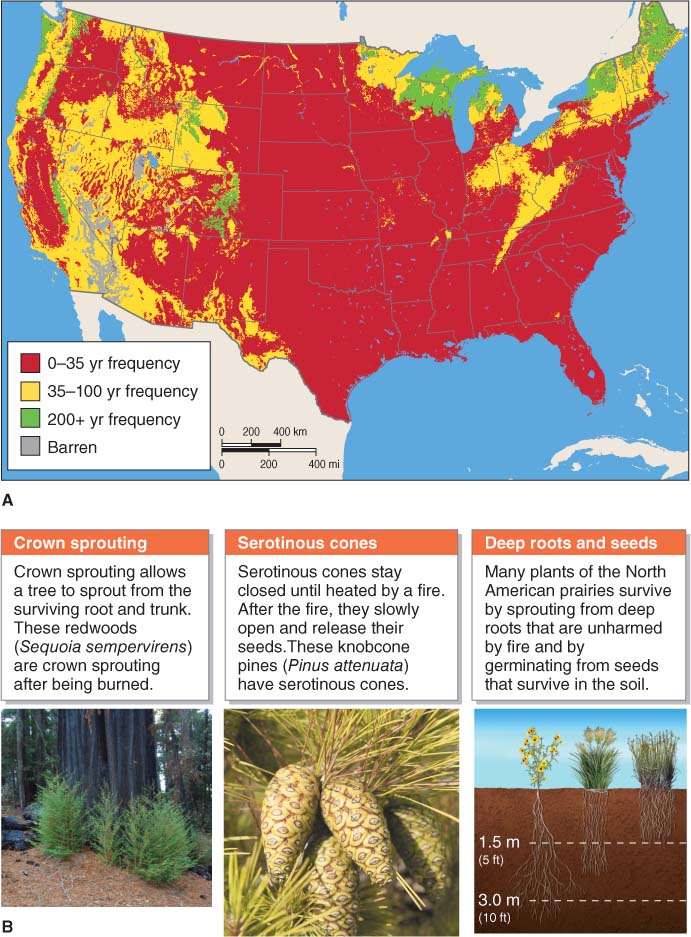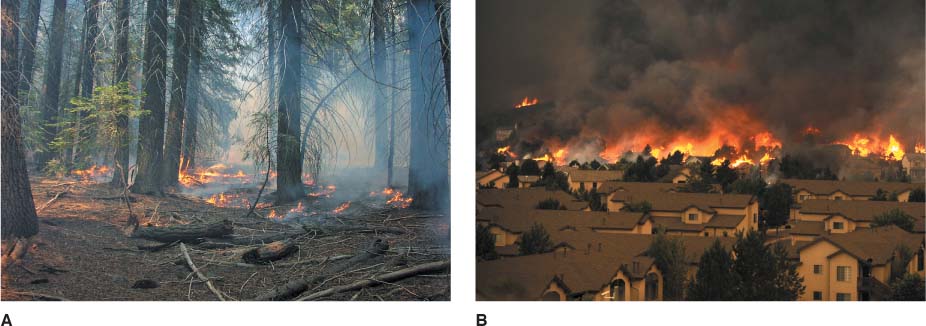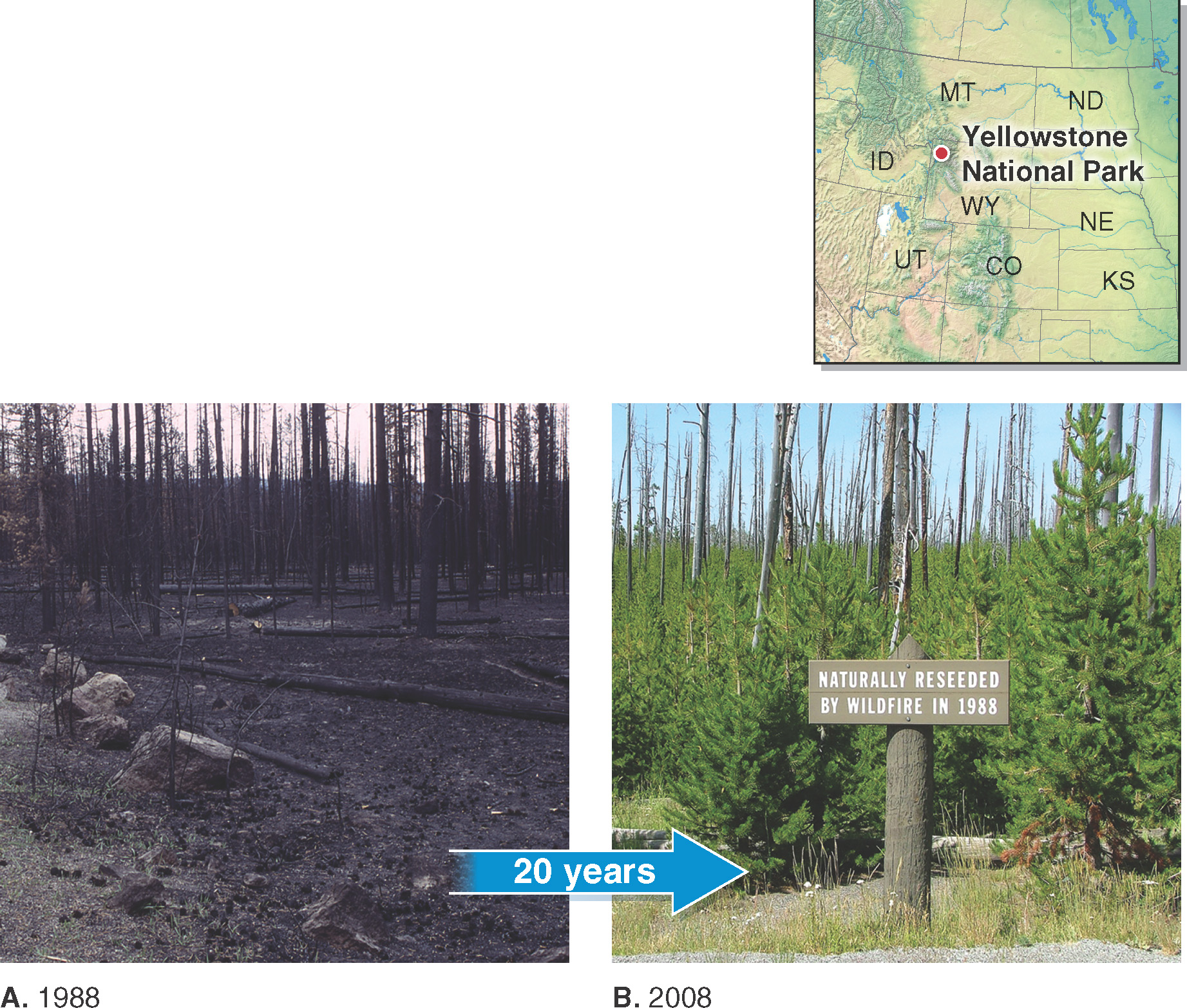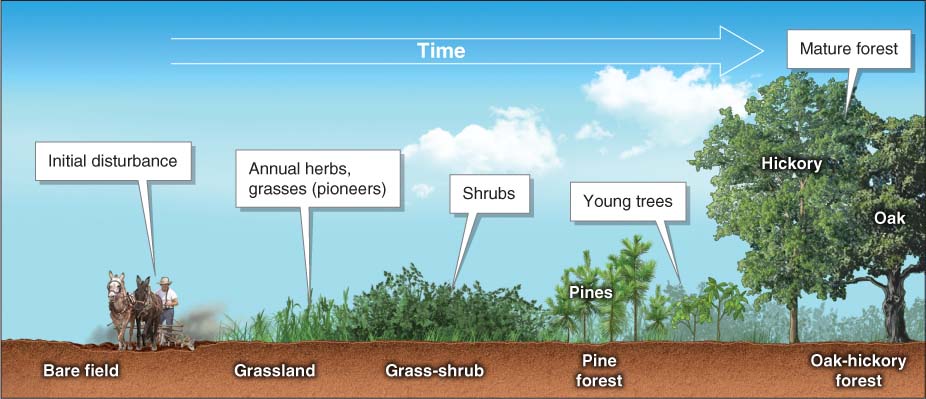7.4 Starting Anew: Ecological Disturbance and Succession
Discuss the role of ecological disturbance and the return of life following disturbance.
We tend to think that balance and equilibrium exist in nature. More often, ecosystems are in a constant state of disequilibrium and change as they adjust to ecological disturbances through the process of ecological succession. An ecological disturbance is a sudden event that disrupts an ecosystem. Ecological succession is the step-
ecological disturbance
A sudden event that disrupts an ecosystem.
ecological succession
The step-
Ecological Disturbance
Ecological disturbances can range from local fires that burn vegetation to massive volcanic eruptions that create an extensive barren landscape. Both biotic (living) forces and abiotic (nonliving) forces can create ecological disturbances. The removal of wolves from Yellowstone by people (see Figure 7.14) was a biotic disturbance, as was the introduction of the non-
Table 7.2 gives some examples of different types and severities of ecological disturbances. In this section, we take a more detailed look at the role of one type of disturbance—
|
|
TYPE OF ECOLOGICAL DISTURBANCE |
SEVERITY |
|---|---|---|
|
ABIOTIC |
Volcanic eruption |
Moderate to severe |
|
Wildfire |
Moderate to severe |
|
|
Wind |
Moderate |
|
|
Flooding |
Moderate |
|
|
Avalanche |
Moderate |
|
|
BIOTIC |
Insect outbreak |
Moderate to severe |
|
Anthropogenic forces (such as logging or farming) |
Moderate to severe |
|
|
Introduction of non- |
Moderate |
Fire is a widespread, common, and important disturbance in most vegetated regions. In many ecosystems, fire is as important as water, light, or soil nutrients. Many plant communities are dependent on fire. Wherever there is enough precipitation for vegetation to grow and a dry and warm season, fire will occur. Before wildfires were suppressed by people, many North American ecosystems had natural fire-

Fire suppression has a long history in North America. In the 1930s, to save property and trees with commercial value, the U.S. Forest Service began a “10:00 a.m.” fire policy. Its aim was to have any given wildfire contained by ten o’clock the morning after it was first reported. Before the policy of fire suppression, surface fires (fires that burn gently on the forest floor and kill few trees) were a common occurrence (Figure 7.20A). But these fires were extinguished by the Forest Service.

Fire suppression led to a buildup of dead and living vegetation, and these high fuel loads resulted in catastrophic canopy fires that could be impossible to extinguish. A canopy fire (or crown fire) burns in the forest canopy (the uppermost layer of branches) and usually kills the trees (Figure 7.20B).
In the past few decades, the essential ecological role of fire has been increasingly recognized. In an attempt to address the problem of fuel buildup in western U.S. forests caused by a century of fire suppression, prescribed burns and mechanical thinning operations (in which vegetation is removed by manual cutting) are sometimes employed to reduce fuel loads.
Ecological Succession: The Return of Life
Given enough time, life returns following fire or any other disturbance (Figure 7.21). There are two types of ecological succession, depending on the severity of the disturbance. Primary succession occurs when life is completely removed from a landscape. Large volcanic eruptions and large landslides are examples of disturbances that can trigger primary succession. In most cases, however, some life survives the disturbance, and ecosystems rebuild through the process of secondary succession.

Ecological succession takes place in stages and may require decades or centuries to complete. A sere is a stage of ecological succession that follows a disturbance. A typical sequence of seres that would occur in the eastern United States is illustrated in Figure 7.22. The return of the former ecosystem can take years to centuries, depending on the severity of the disturbance and the responsiveness of the ecosystem. In the past, scientists used the climax community model, which assumed that a community would persist indefinitely in the absence of any further disturbance. In the example in Figure 7.22, the oak-

The climax community model has been replaced by a view that change and disturbance go on continually. Fire, volcanic eruptions, climate change, non-
